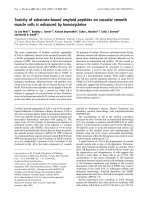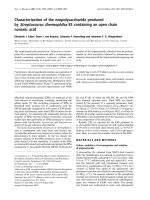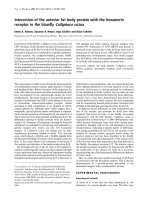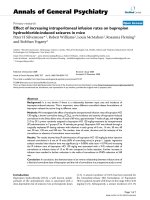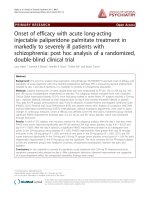Báo cáo y học: " Usefulness of case reports to improve medical knowledge regarding trigemino-cardiac reflex in skull base surgery" doc
Bạn đang xem bản rút gọn của tài liệu. Xem và tải ngay bản đầy đủ của tài liệu tại đây (260.76 KB, 3 trang )
EDI T O R I A L Open Access
Usefulness of case reports to improve medical
knowledge regarding trigemino-cardiac reflex
in skull base surgery
Nora Sandu
1
, Pooan Sadr-Eshkevari
2
, Bernhard J Schaller
1,3*
and for
the Trigemino-Cardiac Reflex Examination Group (TCREG)
Abstract
We describe the discovery of the trigemino-cardiac reflex by Schaller in 1999 and the continued improvement of
the knowledge about the trigemino-cardiac reflex involved in neurosurgery, especially in skull base surgery, during
the past several years. The achieved medical progress could be gained only by the practical experience described
by different case reports and later case series that have been published in several principal scientific journals.
Additionally, we explain the scientific as well as clinical importance of the communication of the case reports on
TCR. Special reference has been given to the validity of the case reports for new phenomena in clinical medicine.
Editorial
Clinical case reports, which are often overlooked by
mainstream scientific journals, represent an important,
maybe even an exclusive, way of communicating new
and unusual clinical findings in medicine to the scient i-
fic community. In addition, they are often the main
source of new knowledge about rare clinical features in
medicine, especially in surgery.
One such example is the discovery of the trigemino-
car diac reflex (TCR), a well-recognized brainstem reflex
that consists of bradycardia, arterial hypotension, apnea
and gastric hypermoti lity [1]. The current knowledge of
this reflex is mainly based on a cornerstone article that
introduced the topic into ne urosurgery and skull base
surgery in 19 99 [1]. Clear proof of the reflex’sexistence
was provided on a causal relationship basis, and the
TCR arc was described to be constituted of trigeminal
and cardioinhibitory vagus nerves as the afferent and
efferent pathways. After this initial case series that sug-
gested for the first time a definition of the TCR based
on clinical and theoretical consideration, the subse-
quently published case reports could therefor e focus on
the differentiation between the peripheral and central
stimulation [2]. These additional clinical data provided
strong evidence of our hypothesis that the TCR trig-
gered by p eripheral stimulation (via the spinal nucleus
of the trigeminal nerve to the Kölliger-Fuse nucleus) is
different from the TCR triggered by central stimulation
(via the nucleus of the solitary tract to the lateral para-
brachial nucleus) [3].
It always represents a substantial problem to generalize
from a few case reports to larger case series. Therefore, a
critical reflexivity is absolutely needed, which we resolved
by performing a causal relationship test in the initial
TCR publication [1]. Thus, the TCR can be prevented by
avoiding stimulation of the afferent pathway or by block-
ing the nerves that conduct the afferent impulses. Such a
cause-and-effect relationship is evidence of a TCR, and
the stimulation of the trigeminal root represents the
afferent pathway. The few single-case reports that fol-
lowed the initial report were therefore also important to
rigorously test our first hypothesis of the existence of this
newly described reflex. If just one such observational case
does not fit completely with the proposition, the hypoth-
esis should be considered generally not valid and there-
fore should be revised or even rejected. This was not the
case with our hypothesis.
Case reports are especially suited for such further scien-
tific investigations and theory building in clinical medicine
because of their in-depth approach. For this reason, we
additionally tested whether skull base operations other
* Correspondence:
1
Department of Neurosurgery, University of Paris, Paris, France
Full list of author information is available at the end of the article
Sandu et al. Journal of Medical Case Reports 2011, 5:149
/>JOURNAL OF MEDICAL
CASE REPORTS
© 2011 Sandu et al; licensee BioMed Central L td. This is an Open Access article distributed under the terms of the Creative Commons
Attribution License ( which permits unrestricted use, distribution, and reproductio n in
any mediu m, provided the original work is properly cited.
than for vestibular schwannoma also demonstrated an
intraoperative occurrence of the TCR, and we finally
found that the phenomenon can also be seen during trans-
sphenoidal surgery [4,5] and during Janetta operations [6].
Because the issue of generalization has appeared in the
(scientific) medical literature with regularity, we have con-
ducted further research for TCR in different skull base
approaches to facilitate this generalization. Such further
case reports [7] and case series [8] also point out the func-
tional importance of the T CR on the surgical outc ome
after skull base surgery. Focusing on hearing function in
patients with vestibular schwannoma has demonstrated
the hypotension owing to the TCR to be a negative prog-
nostic factor for hearing preservation and postoperative
tinnitus [3]. This fact points out that e xtreme or atypical
cases often reveal more information because in them more
basic mechanisms of the disease are activated. In addition,
from both an understanding-oriented and an action-
oriented perspective, it is often more important to clarify
the deeper c ause behind a given clinical picture and its
consequences that describe only signs and symptoms of a
disease and how frequently it occurs.
It is a frequent criticism of case-report-research that
the results are not widely applicable in “real life”.Inparti-
cular, that criticism is underlined by presenting a well-
constructed explanation of the difference between analy-
tic generalization and statistical generalization: “In analy-
tic gene ralization, previously developed theory is used as
a template against which to compare the empirical results
of the case study” [9]. This represents a well-established
manner of work in clinical research. The appropriate
manner of generalization does always assume that some
sample of cases has been usually drawn from a larger
“universe” of cases, but only one is presented. Thus, the
incorrect terminology, such as “small sample size”, arises
as though a single-case study is consider ed unfairly only
as a single respondent. For the TCR, however, we there-
fore published a review paper early in the research of the
TCR [10] i n which we analyzed roughly all cases pub-
lished previously as a large collective and gave a detailed
overview about the theory behind it and could also shed
light on new investigations. This led researchers all over
the world to become interested in this phenomenon and
to popularize the topic of TCR.
Further case reports on the TCR inform about some
risk factors for the intraoperative occurrence of the TCR
[11-13]. S everal factors have been postulated as predis-
posing patients to the TCR on the basis of a few clinical
case reports. These factors include hyperca pnia, hypoxe-
mia, l ight anesthesia, high resting vagal tone in children,
narcotics such a sufentanil and alfentanil, preoperative
b-blockers and calcium channel blockers [3]. Cases such
as the above-cited critical “follow-up cases” can have
more importance in relation to the general clinical
feature of the initial hypothesis than to merely represent
a small sample of patients. If the initial hypothesis also
applies in these “ follow-up cases,” it could also be
expected to be applicable to a large range of patients. In
this manner, by strategically selecting cases, o ne can
arrive at the point at which cases allow generalization as
a particular research methodology. Also, with more un i-
form considerations in reporting the TCR cases, case
series and clinical trials, such statistical analyses of the
literature would become easier and faster.
The TCR is now accepted all over the world on the
basis of our initial definition and is considered one of
the great problems in modern skull base surgery (see,
for example, [14]). This example points out the out-
standing importance of case reports to improve medical
knowledge not only in past centuries but also nowadays.
We hope that this story of success may inspire others to
publish and especially to deeply analyze their special
cases that deal with not yet published clinical features;
this is one of the most important ways that medicine
can advance. In addition, our experience and reports
underline the importance of special journals such as the
Journal of Medical Case Reports that deal only with case
reports and of making great efforts to achieve a high
qua lity of publi cation also in c ase reports and to stimu-
late authors to analyze their special cases.
Acknowledgements
We thank Conor Kennedy for correction of English style and grammar.
Author details
1
Department of Neurosurgery, University of Paris, Paris, France.
2
Farzan
Clinical Research Institute, Tehran, Iran.
3
Associate Editor, Journal of Medical
Case Reports.
Authors’ contributions
NS, PS and BS contributed equally to the writing of the manuscript. All
authors have read and approved the final manuscript.
Competing interests
The authors declare that they have no competing interests.
Received: 2 September 2010 Accepted: 15 April 2011
Published: 15 April 2011
References
1. Schaller B, Probst R, Strebel S, Gratzl O: Trigeminocardiac reflex during
surgery in the cerebellopontine angle. J Neurosurg 1999, 90:215-220.
2. Schaller BJ, Filis A, Buchfelder M: Trigemino-cardiac reflex in humans
initiated by peripheral stimulation during neurosurgical skull-base
operations: its first description. Acta Neurochir (Wien) 2008, 150:715-717.
3. Schaller B, Cornelius JF, Prabhakar H, Koerbel A, Gnanalingham K, Sandu N,
Ottaviani G, Filis A, Buchfelder M, Trigemino-Cardiac Reflex Examination
Group (TCREG): The trigemino-cardiac reflex: an update of the current
knowledge. J Neurosurg Anesthesiol 2009, 21:187-195.
4. Schaller B: Trigemino-cardiac reflex during transsphenoidal surgery for
pituitary adenomas. Clin Neurol Neurosurg 2005, 107:468-474.
5. Filis A, Schaller B, Buchfelder M: Trigeminocardiac reflex in pituitary
surgery: a prospective pilot study. Nervenarzt 2008, 79:669-677.
6. Schaller B: Trigemino-cardiac reflex during microvascular trigeminal
decompression in cases of trigeminal neuralgia. J Neurosurg Anesthesiol
2005, 17:45-48.
Sandu et al. Journal of Medical Case Reports 2011, 5:149
/>Page 2 of 3
7. Schaller B, Rasper J, Filis A, Buchfelder M: Difference in functional outcome
of ipsilateral tinnitus after intraoperative occurrence of the
trigeminocardiac reflex in surgery for vestibular schwannomas. Acta
Neurochir (Wien) 2008, 150:157-160.
8. Schaller BJ: Trigeminocardiac reflex. J Neurosurg 2007, 107:243.
9. Schaller B: Trigeminocardiac reflex: a clinical phenomenon or a new
physiological entity? J Neurol 2004, 251:658-665.
10. Yin R: Case Study Research: Design and Methods. 1 edition. Beverly Hills, CA:
Sage Publishing; 1984.
11. Schaller BJ, Buchfelder M: Delayed trigeminocardiac reflex induced by an
intraorbital foreign body. Opthalmologica 2006, 220:348.
12. Bauer DF, Youkilis A, Schenck C, Turner CR, Thompson BG: The falcine
trigeminocardiac reflex: case report and review of the literature. Surg
Neurol 2005, 63:143-148.
13. Spiriev T, Sandu N, Arasho B, Kondoff S, Tzekov C, Schaller B: A new
predisposing factor for trigemino-cardiac reflex during subdural
empyema drainage: A case report. J Med Case Reports 2010, 4:391.
14. Acioly MA, Carvalho CH, Koerbel A, Löwenheim H, Tatagiba M,
Gharabaghi A: Intraoperative brainstem auditory evoked potential
observations after trigeminocardiac reflex during cerebellopontine angle
surgery. J Neurosurg Anesthesiol 2010, 22:347-353.
doi:10.1186/1752-1947-5-149
Cite this article as: Sandu et al.: Usefulness of case reports to improve
medical knowledge regarding trigemino-cardiac reflex in skull base
surgery. Journal of Medical Case Reports 2011 5:149.
Submit your next manuscript to BioMed Central
and take full advantage of:
• Convenient online submission
• Thorough peer review
• No space constraints or color figure charges
• Immediate publication on acceptance
• Inclusion in PubMed, CAS, Scopus and Google Scholar
• Research which is freely available for redistribution
Submit your manuscript at
www.biomedcentral.com/submit
Sandu et al. Journal of Medical Case Reports 2011, 5:149
/>Page 3 of 3

